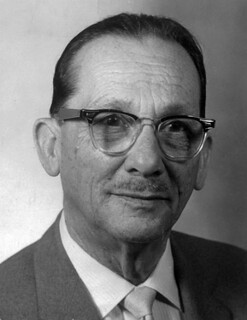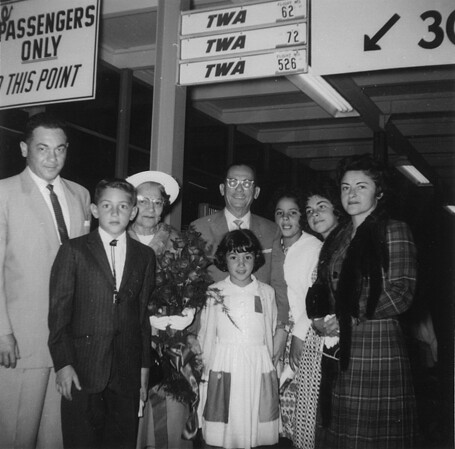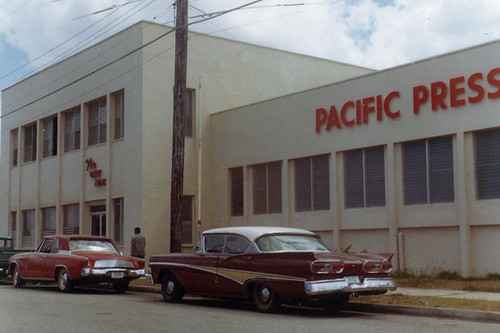View the Flores photo collection here.
Governor of Guam 1960-1961
Joseph Flores (1900 – 1981) was the first CHamoru to serve as governor of Guam. He also founded Guam’s first locally owned newspaper and financial institution, and was one of Guam’s most prominent post World War II businessmen.
Early Life
Flores was born 12 August 1900 on Guam, the son of Lagrimas Flores and an Englishman, Dr. Cromwell, whom she met on a whaling ship returning from Manila in 1899. His grandparents were Carmen Baza Esteban and Jose Aguon Flores.
Flores was educated at the old Almacen school next to the Governor’s Palace. He first worked as a messenger for the Naval government on Guam for 25 cents a day and later as an operator for the Navy’s cable station as a teen. In 1917, in the middle of World War I, he was one of the few CHamorus who were allowed to enlist in the US Navy and shipped out of Guam, hoping to become a part of the adventure of the war. While he did not see combat, serving as a steward, he served on maneuvers in Cuba and British West Indies after the war was over.
After his Navy stint, Flores settled in San Francisco for 30 years, where he married his wife, Angela Perez. The couple had one son, Edward, and raised him there. Joseph Flores worked at various companies, including a grave-registration agency, a direct-mail advertising company, and the Santa Fe Railroad Company.
While he made waybills (shipping documents) for the railroad, he used his spare time to open a print shop in his San Francisco home and start a four-page weekly newspaper called the South of Market Street Tribune, which was distributed free. The paper was profitable in the 1920s but was wiped out by the Great Depression and a printers’ strike. Flores stayed in San Francisco where he prospered in the 1930s. By the end of World War II he had five weekly newspapers in the area.
Flores decided to return to war-ravaged Guam in 1947 to help his two brothers, Joaquin and Jesus. Their company, named “Flores Brothers,” opened an import business and general merchandise store that operated where BankPacific now sits in Hagåtña.
Career
When the US Navy decided to sell its publishing business three years later, Flores was awarded the bid for $37,000. Flores was not the highest bidder but the Navy sold it to him anyway because of his publishing background and business success.The Guam Daily News was born in Navy Quonset quarters in Agana Heights making Flores the first local newspaper publisher.
Flores published the Daily News for 20 years and also founded the Territorial Sun, a Sunday newspaper. In 1970, he sold the printing and newspaper business to Chin Ho, publisher of the Honolulu Star Bulletin for $1.2 million. Ho sold the company to publishing giant Gannett Corporation a year later. In 2021 it was purchased by Kaleo Moylan, a local businessman.
Flores also went into a joint venture to found Guam Savings and Loan on 7 July 1954, now BankPacific currently run by his grandson Phillip Flores. His partners were Pedro Martinez, Pedro M. Ada, Ignacia Bordallo Butler, Frank Perez, Joaquin Guerrero, Felix M. Camacho and Eduardo T. Calvo. They sold about 125 shares to start the first financial institution chartered on Guam and the first to be locally owned. It was also the first to sell shares to the public.
Flores and his associates also opened the first loan company on Guam that same day, the Marianas Finance Corporation, and an insurance company, Pacific American Insurance Corporation. The insurance company went out of business after Typhoon Karen in 1962. Flores, however, paid the outstanding claims out of his own pocket.
He and his brothers also opened the first airline on Guam, Guam Air Lines. Flores had a car dealership as well, selling English Sunbeam Alpines and Hillman autos in the 1950s in Tamuning where BankPacific and Marianas Finance are now.
Governor of Guam for one year
In 1960, US President Dwight D. Eisenhower, a Republican, appointed Flores as the first locally born governor of Guam. Flores was not sure he wanted the position, as he and his brothers were busy growing their businesses, but he finally agreed to the proposal. Flores was sworn in to office on 9 July 1960. He was the kind of man the Republicans were looking for – reliable, conservative, successful in business and active in the community.
Flores saw his appointment as a testing of the CHamoru people. In his inaugural address he said:
There is no doubt in my mind that from this time on, the eyes of the nation will be upon us, watching and probing step by step to evaluate our integrity and our ability in the discharge of those responsibilities which are inherent in self-government…
The placing in office of the first Guamanian governor paves the way toward the last lap on our journey to self-government, a God-given privilege engendered only by freedom-loving people. We are all aware, of course, that the price of freedom here as elsewhere is eternal vigilance and that unless we are constantly alert, we stand to lose what we hope to keep…
You will note that less than ten years have elapsed between the effective date of the Organic Act and the inauguration of the first Guamanian governor of the territory. As history goes, this is a very short period of time. It speaks well for Guam that within so short a time the people of the territory, by their conduct, have so inspired confidence that our Nation felt we were ready for the big step, we, as a people, are taking today. I can only hope and pray that during the years ahead we will continue to advance and will continue to demonstrate that the faith and confidence of the government of the United States have not been misplaced…
Today we begin the crucial test of our political maturity. From this day forward our ability to govern ourselves will be measured in terms of deeds rather than words. As your Chief Executive, it is my desire and my pledge to do everything in my power to provide to the people of Guam an effective and efficient government service that is well within our financial ability to undertake.
It is expected, of course, that sometime during my administration, there will be differences of opinion on particular issues among various branches of our government and between the government on the one hand and perhaps some individuals on the other. We are only human! But, I would like to think that when the chips are down and the welfare of the community is at stake, we will put aside our personal differences and aggrandizement to rally behind the common good. In this spirit, the affairs of the territory will not be placed in jeopardy and the ability to govern ourselves will not be questioned.
Flores kept the previous department and agency heads on, only making new appointments as vacancies came up. He named Dr. Pedro Sanchez, Dean of the Territorial College of Guam, as his executive assistant. Manuel FL Guerrero, later to be named Governor of Guam, retained his position as assistant secretary of Guam.
Because of Flores’s efforts, the University of Guam became a land-grant college a few years later. He had earlier supported the appointment in 1957 of the first CHamoru, Dr. Pedro Sanchez, to be dean of the then Territorial College of Guam. Sanchez, a PhD in educational administration from Stanford University, also co-authored with Paul Carano “A Complete History of Guam” first published in 1964, providing the island with its first comprehensive history of the island.
The college moved in 1960 to its present location along the cliff-line in Mangilao. Flores laid the ground work for administrative control of the College to be transferred from the Department of Education to a five-member governing Board of Regents in 1963 when it became a four-year degree granting institution.
As governor he advocated self-rule for Guam, opened his doors to all residents, and established new public health centers in Mangilao, Piti, Talo’fo’fo, and Asan. He also saw to it that the Department of Public Works paved the Hågat-Humåtak Road for the first time. The road (an old pathway) had been widened and surfaced by the Seabees just after World War II but never paved. Once completed it finally became possible to drive all the way around the island (80 miles) on a paved road.
Another issue Flores faced during his term as governor was with alien laborers who had been brought to Guam by the Department of Defense. A US immigration ruling in 1960 permitted certain categories of non-immigrant alien workers admitted to Guam prior to December 1952 to build the military bases to remain on island as permanent US residents. By February 1962 1,700 Filipino workers obtained permanent resident status on Guam, most of who eventually became American citizens by applying for a “green card” and subsequently petitioning for their family members to move to Guam as well and become US citizens.
The ruling was controversial at the time because while some people welcoming the new residents, others were concerned about their influence in the newly developing democracy. Because of this ruling Filipinos are now the second largest ethnicity on Guam, right behind CHamorus.
Pan American Airways inaugurated east west jet airliner service across the Pacific via Guam in Boeing 707 airliners in 1960 while Flores was governor. That same year the US Congress extended the Social Security system on Guam by PL 86-778. In addition, Bank of Hawai’i was licensed to do business on Guam in 1961, providing competition with the Bank of America and Guam Savings and Loan.
When President John F. Kennedy, a Democrat, won the election for president in 1961, Flores submitted his courtesy resignation. Bill Daniel, from Texas became Guam’s next governor for three years but then Manuel FL Guerrero succeeded him and Guam has had a CHamoru governor ever since.
Flores was one of the founders of the Republican Party of Guam in 1966 after its predecessor, the Territorial Party, lost all its seats to the Democrats in that year’s elections.
He also owned several office buildings and Casa de Flores, a motel-apartment complex in Agana Heights.
Flores also served as chairman of the University of Guam Board of Regents, chairman of the Territorial Planning Commission, and a member of the Guam Chamber of Commerce, Young Men’s League of Guam, the Rotary Club and the Elks Club. He was also quite proud of being a Knight of St. Sylvester. This honorary title, awarded by the Pope, recognizes Catholic laymen who are actively involved in the life of the church, particularly as it is exemplified in the exercise of their professional duties.
He was inducted into the Guam Chamber of Commerce Hall of Fame in 1992 as one of the first laureates.
By Leo Babauta and Shannon J. Murphy
For further reading
I Manfåyi: Who’s Who in Chamorro History. Vol. 1. The Hale’-ta Series. Hagåtña: Political Status Education and Coordinating Commission, 1995.
Rogers, Robert. Destiny’s Landfall: A History of Guam. Honolulu: University of Hawai’i Press, 1995.
Sanchez, Pedro C. Guahan Guam: The History of Our Island. Hagåtña: Sanchez Publishing House, 1987.





